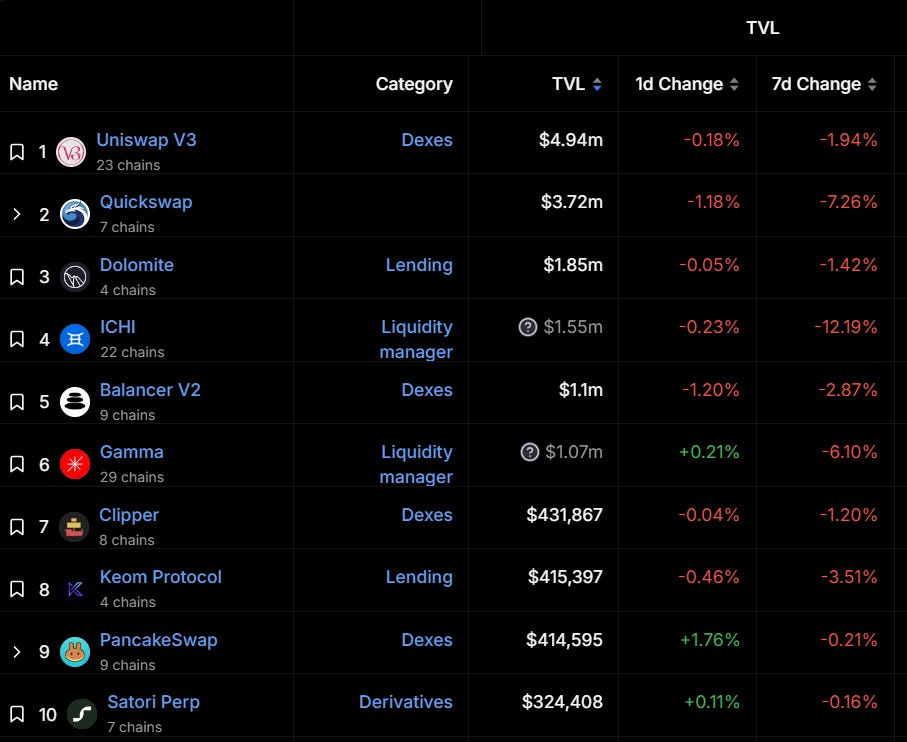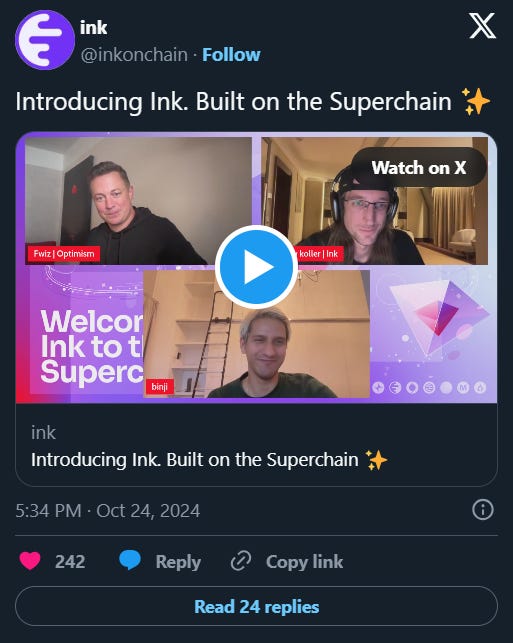The Surge of Ethereum L2 | Layer 2 Review
Quick Reads and Hot Links Covering the People and Projects Who Are Scaling Ethereum
Dear Frens,
Welcome to the Layer 2 Review.
The Ethereum Interop Forum, a gathering dedicated to advancing interoperability across Ethereum L2, would be happening on November 16, at Bangkok. The forum hopes to unite core contributors to iterate on and refine shared standards for cross-chain interop. This event will prioritize participants with a proven track record in L2 research and development. If you fit the bill, visit the forum website to apply to attend.
In other news, Base is introducing fault proofs to its mainnet on October 30, a significant milestone on its path to decentralization on the Superchain. The Base team, in close collaboration with Optimism, aims to ensure a seamless and secure rollout of the fault proofs. Speaking of the Superchain, Ink is the latest protocol to join the train. Built by Kraken, one of the world’s leading crypto exchanges, Ink hopes to be the hub of seamless DeFi experience.
Arbitrum has unveiled a new configuration that enables faster withdrawals on its Orbit chains. So, instead of waiting the usual 7 days for Optimistic rollups, transactions on these chains would achieve finality in just about 15 minutes. This issue's editorial focuses on Ethereum's rollup-centric roadmap for scaling, covering key points from Vitalik Buterin's recent article on Ethereum's scaling efforts.
Stay tuned for more exciting updates. Enjoy the review and have a great time.
Contributors: Lucent, Melasin, Tonytad, Boluwatife, Kornekt, WinVerse
This is an official newsletter of BanklessDAO. Please subscribe and share to help us grow our audience as we fulfill our mission to build user-friendly crypto onramps.
🗞️ Ecosystem Updates
🆕 Fast Withdrawals is Now Supported With Select Orbit Chains and RaaS Providers.
🔀 Welcoming Inkonchain to the Superchain!
⚡World chain by World Coin is Now Live on the Superchain and Powered by Alchemy Rollups
⭕ Mode Introduces Season 3: veMODE
🔥 Hot News
Kraken, one of the world's leading crypto exchanges, has announced its new Layer 2 network called Ink, built on the Superchain. By building on the Superchain, Kraken has added to Optimism's growing influence in the Layer 2 space.
To mark Ink's launch, a special NFT was created in collaboration with Optimism, which you can mint on Zora. These limited-time NFTs will serve as proof of being present at Ink's beginning. The launch timing shows good market awareness, as more companies are looking to scale their operations using Ethereum-based solutions. To learn more about the development, check out the broadcast attached below.
🏛 Governance
💬 Proposals in Discussion
Arbitrum
[RFC] Arbitrum as the Home of Builders - embracing Chain Abstraction
[Non-Constitutional] Arbitrum DAO Delegate Code of Conduct + Formalizing the DAO’s Operations
[Election & Application Thread] V2 Arbitrum Research & Development Collective
Optimism
Polygon
The Surge of Ethereum L2
Author: Kornekt
Since inception, scaling has been a major challenge for Ethereum. The network has sought to expand its capacity to handle high transaction volumes while preserving the critical characteristics of decentralization and security. With the blockchain’s demand constantly growing, Ethereum's future lies in its ability to build around its rollup-centric scaling model.
On Oct. 17, 2024, Vitalik Buterin released the second part of his article series on the “Possible Futures of the Ethereum Protocol.” The lengthy article focused on ongoing efforts around Ethereum scaling in the phase termed “the Surge.” Key goals of the Surge phase include:
Achieving 100,000+ transactions per second (TPS) on L1+L2.
Preserving the decentralization and robustness of L1.
Ensuring that at least some L2s inherit Ethereum's core properties of trustlessness, openness, and censorship resistance.
Promoting maximum interoperability among L2s so that Ethereum functions as a unified ecosystem.
The article goes into detailed analysis of the progresses so far and the work that’s left to be done to achieve the Surge milestones. Here, we provide a high-level summary of the article in seven top points so you get all the important details. All that's covered in this summary are as directly said or inferred from the original piece. This summary is only meant to provide an overview and inspire you to give the article a full read.
#1. The Rollup-Centric Roadmap
Ethereum initially had two primary scaling strategies: sharding and Layer 2 (L2) protocols. While sharding splits the network into several nodes, Layer 2 protocols function as secondary networks on top of Ethereum, keeping most data and computation off-chain.
L2 protocols' nomenclature has evolved over time, being called state channels in 2015, Plasma in 2017, and ultimately rollups in 2019. Ethereum's current roadmap emphasizes a rollup-centric approach. This year, the roadmap has experienced significant progress, especially with the data bandwidth increase on L1 via blobs.
#2. Overcoming the Trilemma
Ethereum’s early attempts at scaling ran into the scalability trilemma, but advancements in data availability sampling and SNARKs (Succinct Non-Interactive Argument of Knowledge) address these issues. Meanwhile, Plasma architectures coupled with SNARK enhancements also allow Ethereum to solve the trilemma and scale more effectively.
Ethereum underwent the Dencun upgrade on March 24, this added ~375 kB per slot of data availability bandwidth. However, the network aims for greater scalability, targeting 16 MB of data per slot in the medium term, which could push the network to 58,000 TPS when combined with data compression on rollups.
#3. Compression of Rollup Data
A significant barrier to scalability in rollups is the large amount of on-chain data each transaction requires. However, data compression techniques could significantly reduce this burden.
These techniques include Zero-byte compression, Signature aggregation, Pointer-based address replacement, and Custom serialization for transaction values to make data more compact. Data compression will require technical implementation but could allow Ethereum to achieve its scalability goals more easily.
#4. Plasma Systems and Hybrid Solutions
The article discusses Generalized Plasma, an evolution of earlier Plasma scaling solutions. Plasma systems have improved significantly since their early iterations. New SNARK-powered Plasma systems simplify the process, offering higher scalability and broader applicability. Hybrid plasma/rollup designs such as Intmax can also be explored, allowing for extremely high scalability and privacy, with capacities reaching up to 266,667 TPS.
#5. Layer 2 Maturity
Most rollups today still have a long way to go to achieve full trustlessness. While some have attained Stage 1, the goal is to have rollups advance to Stage 2. The hurdles of attaining Stage 2 can be overcome either through formal verification or using multi-prover systems. Both of these advancements will require significant research and development to reach full implementation.
#6. Cross-chain Interoperability
The current L2 ecosystem faces challenges related to interoperability. To create a unified experience, Ethereum needs cross-L2 improvements. This would involve introducing chain-specific addresses, chain-specific payment requests, standardized protocols for cross-chain swaps and gas payment, Light clients, keystore wallets, more radical “shared token bridge” ideas, and synchronous composability.
#7. Scaling Layer 1 Execution
While Ethereum’s rollup-centric roadmap focuses on scaling through L2s, there’s still a need to continue scaling Layer 1 to mitigate the risks that may arise if L1 remains too limited in processing transactions.
Potential strategies for scaling L1 include increasing gas limit, identifying features and computation that can be made cheaper without significant tradeoffs, and Ethereum may also explore native rollups, which would involve creating multiple parallel EVM instances within the protocol itself.
Conclusion
The article provides a comprehensive view of Ethereum's roadmap for scaling. The future of the network hinges on resolving technical challenges like data availability, proof system maturity, and cross-L2 interoperability. With these advancements, Ethereum aims to achieve massive scalability while preserving its core ethos of decentralization and security.
Read the full article to get a complete breakdown and explanation of the points highlighted here.
📈 Data
Total Value Locked on L2s is About $38 billion!

Top Ten Projects by Total Value Locked:

🔭 Project Watch
Arbitrum
Top Projects by TVL in the Last 7 Days

Optimism
Top Projects by TVL in the Last 7 Days

Base
Top Projects by TVL in the Last 7 Days

zkEVM
Top Projects by TVL in the Last 7 Days

🔥 L2 Fees and Costs Update
Transaction Fees as of October 24, 2024:




